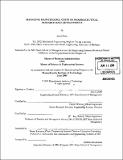| dc.contributor.advisor | Daniel Whitney and Roy E. Welsch. | en_US |
| dc.contributor.author | Butts, Jared (Jared C.) | en_US |
| dc.contributor.other | Leaders for Manufacturing Program. | en_US |
| dc.date.accessioned | 2009-11-06T16:36:03Z | |
| dc.date.available | 2009-11-06T16:36:03Z | |
| dc.date.copyright | 2009 | en_US |
| dc.date.issued | 2009 | en_US |
| dc.identifier.uri | http://hdl.handle.net/1721.1/49792 | |
| dc.description | Thesis (M.B.A.)--Massachusetts Institute of Technology, Sloan School of Management; and, (S.M.)--Massachusetts Institute of Technology, Engineering Systems Division; in conjunction with the Leaders for Manufacturing Program at MIT, 2009. | en_US |
| dc.description | Includes bibliographical references (p. 66). | en_US |
| dc.description.abstract | Drug Discovery is a race to be the first to patent a drug that meets a significant medical need in the world. Many pharmaceutical companies are now using automation extensively to improve consistency and aid personnel in testing the millions of potential drug candidates within their labs. Because these machines play an important role in drug discovery, there is significant interest in managing their maintenance. The concern is that downtime is hampering the efforts of drug discovery. This project has sought to reduce that downtime and manage maintenance costs by working with the Technical Operations Group, Novartis' in-house maintenance team. The main objectives have been to devise a better way for evaluating maintenance contracts, improve the availability of the equipment, and instill a culture of continuous improvement in the group. This study shows that maximizing equipment utilization should be a higher priority than reducing downtime. The data show that the high throughput systems are only used an average of three days a week. Reducing downtime, which is most often measured on the scale of minutes, is unlikely to bring about the gains that would be realized by improving capacity utilization. Current metrics and data collection procedures are ineffective for determining automation needs and performance as well as engineer performance. A new system for data collection was implemented along with improvement projects as an introduction to lean principles, with the primary objective being a self-sustaining system of finding process improvements. | en_US |
| dc.description.abstract | (cont.) Contracts were evaluated along four criteria: the indispensability of the equipment under contract, the adjusted replacement cost, the level of customization, and the age of equipment. The end results of the internships include a metric gathering system that more closely monitors engineer activity as opposed to equipment activity, completed improvement projects such as the complete overhaul of the tool room including inventory management as well as an automated error log system, and a way of evaluating contracts that will reduce costs without sacrificing performance. | en_US |
| dc.description.statementofresponsibility | by Jared Butts. | en_US |
| dc.format.extent | 81 p. | en_US |
| dc.language.iso | eng | en_US |
| dc.publisher | Massachusetts Institute of Technology | en_US |
| dc.rights | M.I.T. theses are protected by
copyright. They may be viewed from this source for any purpose, but
reproduction or distribution in any format is prohibited without written
permission. See provided URL for inquiries about permission. | en_US |
| dc.rights.uri | http://dspace.mit.edu/handle/1721.1/7582 | en_US |
| dc.subject | Sloan School of Management. | en_US |
| dc.subject | Engineering Systems Division. | en_US |
| dc.subject | Leaders for Manufacturing Program. | en_US |
| dc.title | Managing maintenance costs of pharmaceutical research and development | en_US |
| dc.type | Thesis | en_US |
| dc.description.degree | S.M. | en_US |
| dc.description.degree | M.B.A. | en_US |
| dc.contributor.department | Leaders for Manufacturing Program at MIT | en_US |
| dc.contributor.department | Massachusetts Institute of Technology. Engineering Systems Division | |
| dc.contributor.department | Sloan School of Management | |
| dc.identifier.oclc | 457238757 | en_US |
